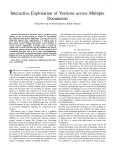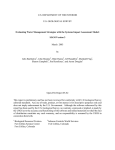Download A User's Guide to Proper Names
Transcript
A User’s Guide to Proper Names Their Pragmatics And Semantics Anna Pilatova A User’s Guide to Proper Names Their Pragmatics And Semantics ILLC Dissertation Series DS-2005-04 For further information about ILLC-publications, please contact Institute for Logic, Language and Computation Universiteit van Amsterdam Plantage Muidergracht 24 1018 TV Amsterdam phone: +31-20-525 6051 fax: +31-20-525 5206 e-mail: [email protected] homepage: http://www.illc.uva.nl/ c 2005 by Anna Pilatova Copyright Cover design Dragan Dragin and Anna Pilatova Printed and bound by AMOS, Prague. Promotores: Prof. dr. E.C.W. Krabbe Prof. dr. M.J.B. Stokhof Beoordelingcommissie: Prof. dr. A.G.B. ter Meulen Prof. dr. R.A. van der Sandt Prof. dr. N. U. Salmon ISBN: 90–5776–138–6 Rijksuniversiteit Groningen A User’s Guide to Proper Names Their Pragmatics And Semantics Proefschrift ter verkrijging van het doctoraat in de Wijsbegeerte aan de Rijksuniversiteit Groningen op gezag van de Rector Magnificus, dr. F. Zwarts in het openbaar te verdedigen op donderdag 8 september 2005 om 13.15 uur door Anna Pilatova geboren op 30 maart 1971 te Praag (Tsjechi˝e) To my grandmothers, Rachil and Jaryna, some of the strongest and most extraordinary women I have had the honour to meet. v Contents Acknowledgments xiii Preface 1 Part I 5 1 Outlining the Field and Introducing Some of the Players 1.1 What Should a Theory of Reference of Proper Names Do For Us? . . . . . . . . . . . . . . . . . . . . . . . 1.2 Semantic Theory and a Theory of Meaning . . . . . . 1.3 Descriptive Semantics . . . . . . . . . . . . . . . . . . 1.4 Foundational Semantics . . . . . . . . . . . . . . . . 1.5 Semantics of Modals . . . . . . . . . . . . . . . . . . 1.6 The Upshot . . . . . . . . . . . . . . . . . . . . . . . 1.7 Setting the Scene . . . . . . . . . . . . . . . . . . . . 1.7.1 Three Senses of ‘Sense’ . . . . . . . . . . . . . 1.7.2 The New Theories of Reference . . . . . . . . 1.7.3 Introducing Some New Notions . . . . . . . . 1.8 Conclusion . . . . . . . . . . . . . . . . . . . . . . . . vii 9 9 10 11 13 14 16 19 21 22 23 35 2 Descriptive Semantics 2.1 Introduction . . . . . . . . . . . . . . . . . 2.2 Arguing for Rigid Designation . . . . . . . 2.2.1 The Modal Argument . . . . . . . . 2.2.2 The Epistemological Argument . . 2.2.3 The Semantic Argument . . . . . . 2.3 Assessing the Three Arguments . . . . . . 2.4 A Direct Argument for Rigidity . . . . . . 2.5 Kaplan’s Distinctions . . . . . . . . . . . . 2.5.1 Contexts of Use and Circumstances of Evaluation . . . . . . . . . . . . 2.5.2 Content and Character . . . . . . . 2.6 Singular Terms and Singular Propositions 2.7 Kaplan’s Problems With Names . . . . . . 2.8 Conclusion . . . . . . . . . . . . . . . . . . . . . . . . . . . . . . . . . . . . . . . . . . . . . . . . . . . . . . . . . . . . . . . . . . 37 37 38 38 41 42 44 47 51 . . . . . . . . . . . . . . . . . . . . . . . . . . . . . . 51 52 54 57 58 3 Modal Statements, Individuals, and Essences 61 3.1 Lewis’s Possible-world Framework . . . . . . . . . . . 62 3.1.1 Lewis: Let’s Be Realistic . . . . . . . . . . . . 63 3.1.2 Adopt a Counterpart! . . . . . . . . . . . . . . 66 3.1.3 The Indexical Theory of Actuality, Natural Remedies, and the Man in the Street 70 3.1.4 Essentialism: A Matter of Choice? . . . . . . 74 3.1.5 A Battle of Individuals: Transworld Versus Worldbound . . . . . . . . . . . . . . . 75 3.1.6 Can We Survive a Change? . . . . . . . . . . 79 3.1.7 Looking Into Possible Worlds . . . . . . . . . 82 3.1.8 Counterfactuals and Worldbound Individuals . 84 3.1.9 Conclusion . . . . . . . . . . . . . . . . . . . . 86 3.2 Kripke’s Approach to the Semantics of Modal Statements . . . . . . . . . . . . . . . . . . . . . . . . . . 88 3.2.1 Stipulating Possible Worlds . . . . . . . . . . 89 3.2.2 Two Versions of Haecceitism . . . . . . . . . . 91 3.2.3 Haecceities and Reduction . . . . . . . . . . . 96 3.2.4 Persistence and Obstinacy . . . . . . . . . . . 97 3.2.5 Possible Worlds and Imagination . . . . . . . 100 viii 3.3 3.4 3.2.6 What is a priori? . . . . . . . . . . . . . . . . 3.2.7 Natural Kinds and Haecceities . . . . . . . . . 3.2.8 Necessary Statements and Their Commitments 3.2.9 Kripke’s Scientific Realism . . . . . . . . . . . 3.2.10 Kripke Without Metaphysical Assumptions . . 3.2.11 Conclusion . . . . . . . . . . . . . . . . . . . . Stalnaker’s Worlds . . . . . . . . . . . . . . . . . . . 3.3.1 Stalnaker’s Motivation . . . . . . . . . . . . . 3.3.2 Possible Worlds . . . . . . . . . . . . . . . . . 3.3.3 Proposition . . . . . . . . . . . . . . . . . . . 3.3.4 Context . . . . . . . . . . . . . . . . . . . . . 3.3.5 The Possible and The Actual . . . . . . . . . 3.3.6 Content . . . . . . . . . . . . . . . . . . . . . 3.3.7 Narrow and Broad Content . . . . . . . . . . 3.3.8 The Resulting Picture . . . . . . . . . . . . . Conclusion . . . . . . . . . . . . . . . . . . . . . . . . 4 Foundational Semantics 4.1 Believing in Propositions . . . . . . . . . . . . . . 4.1.1 Do We Believe in Necessary Propositions? 4.1.2 Why Put Up With Logical Omniscience? . 4.1.3 Propositions and Worldbound Individuals 4.1.4 Lewis’s Folk-psychological Approach to Foundational Semantics . . . . . . . . . . 4.1.5 The Realist Concludes . . . . . . . . . . . 4.2 Propositions in Kripke . . . . . . . . . . . . . . . 4.2.1 Kripke is Puzzled About Pierre . . . . . . 4.2.2 Naive Contextualism . . . . . . . . . . . . 4.2.3 The Hidden Premise . . . . . . . . . . . . 4.2.4 Sophisticated Localism . . . . . . . . . . . 4.2.5 Keeping Files . . . . . . . . . . . . . . . . 4.2.6 What Pierre Taught Us . . . . . . . . . . 4.2.7 One Name or Two . . . . . . . . . . . . . 4.2.8 Conclusion . . . . . . . . . . . . . . . . . . 4.3 Stalnaker and Necessary Propositions . . . . . . . . . . . . . . . . . . . . . ix 101 105 111 114 117 119 121 122 124 128 130 136 141 146 148 150 . . . . . . . . 153 154 156 157 160 . . . . . . . . . . . . . . . . . . . . . . 165 169 170 173 178 182 187 191 192 195 200 . . 201 4.4 4.5 4.3.1 Storing Sentences in Boxes . . . . . . . . . . 4.3.2 Belief Content and Belief Representation . . 4.3.3 Question-Answer Machine . . . . . . . . . . Answering Our Problems . . . . . . . . . . . . . . . 4.4.1 Preconditions of Omniscience . . . . . . . . 4.4.2 Possible Worlds Under the Magnifying Glass 4.4.3 Shifty Propositions and Unstable Individuals 4.4.4 Partial Worlds and Kindred Nightmares . . 4.4.5 A Griceful Interlude . . . . . . . . . . . . . 4.4.6 Stalnaker’s Limits . . . . . . . . . . . . . . . Conclusion . . . . . . . . . . . . . . . . . . . . . . . Part II . . . . . . . . . . . 202 208 212 214 215 218 219 222 223 227 228 228 5 User-friendly Descriptive Semantics 5.1 Introduction . . . . . . . . . . . . . . . . 5.2 Why Not Descriptivism? . . . . . . . . . 5.3 The Non-essential Kripke . . . . . . . . . 5.4 Where Does Essentialism Belong? . . . . 5.5 Where Should Essentialism Belong? . . . 5.6 What Do We Learn From Counterfactual 5.7 Conclusion . . . . . . . . . . . . . . . . . . . . . . . . . . . . . . . . . . . . . . . . . . . . . . . . . . . . Statements? . . . . . . . 6 Foundational Semantics: Names, Indexicality, Ambiguity 6.1 Outlining the Problem . . . . . . . . . . . . . . . 6.1.1 Indexicality, Overt and Hidden . . . . . . 6.1.2 From The Indexical Point of View . . . . . 6.2 Names and Context Dependence . . . . . . . . . . 6.2.1 Variability of Proper Names . . . . . . . . 6.2.2 Problems for Rigid Designation? . . . . . . 6.3 Introducing Names Into Language . . . . . . . . 6.3.1 What’s In a Name? . . . . . . . . . . . . 6.3.2 Non-standard Uses of Names . . . . . . . . 6.4 Calling People by Their Names . . . . . . . . . . x 231 231 232 236 238 241 245 249 and 251 . . 252 . . 252 . . 255 . . 258 . . 258 . . 260 . . 261 . . 262 . . 264 . . 265 6.5 6.6 6.7 6.8 6.9 Individuating Names . . . . . Context . . . . . . . . . . . . Dialogue and Norms . . . . . Application to Problems . . . Ambiguity versus Indexicality 6.9.1 Learning from Aphasia 6.10 Conclusion . . . . . . . . . . . . . . . . . . . . . . . . . . . . . . . . . . . . . . . . . . . . . . . . . . . . . . . . . . . . . . . . . . . . . . . . . . . . . . . . . . . . . . . . . . . . . . . . . . . . . 268 271 273 274 284 288 293 7 Final Review 295 Bibliography 301 Name Index 311 Subject Index 313 Nederlandstalige Samenvatting 319 xi Acknowledgments I would like to thank everyone who helped me to write this thesis, and apologise to anyone whom I might forget to mention. I received support, ideas, and encouragement from institutions, supervisors, colleagues, my students, people at conferences, my friends, and family. The writing of this thesis co-incided with the years I spent in The Netherlands, and I want to use this opportunity to express my gratitude to the people who were during this time a part of my life, who helped me make Amsterdam my home, and Groningen my second home. Hence the unusual length of this section. While writing this thesis, I was a part of two departments, and had the good fortune of being able to profit from many events and lectures organised both by the Department of Philosophy of the University of Groningen and by the Department of Philosophy of the University of Amsterdam, and the ILLC, with which this department is associated. My research was supported by a grant I received from the Ubbo Emmius Funds, which are administered by the University of Groningen. I want to thank Prof. Theo Kuipers, who allowed me to divide my time between Groningen and Amsterdam. Without Steve Thomas, I would have probably never moved to Amsterdam in the first place. I want to thank him for his friendship and support. I was extraordinarily fortunate in having Erik Krabbe and Martin Stokhof as my supervisors. I could not have finished this project without their professional and personal support or without their xiii faith in the topic and in my ability to deal with it. Erik Krabbe read my writing with attention to detail that could hardly be surpassed. He drew my attention to arguments that were not quite finished, and to ways in which I could simplify them. He kept me from assuming too much of the reader, and if this thesis is relatively easy to get through, he deserves a lot credit for it. His contagious sense of humour and passion for the English language contributed to the enjoyment and edification I drew from our consultations. Thank you. Martin Stokhof started working with me even before I had an official Ph.D. position. For many years our weekly consultations were a part of my life, a part I miss. Martin Stokhof has a gift for asking questions that are difficult not because they are intricate but because they go to the core of the problem. He pointed me in useful directions, and raised objections that helped improve the work. He is an extremely good devil’s advocate, and I hugely enjoyed our discussions. Thank you. I enjoyed teaching at the University of Groningen, and got a lot back from my students. I had the opportunity to exchange ideas at the regular PCCP meetings and meetings of Groningen logicians (the Grolog lectures). I also presented some of my work there and received valuable comments. The same should be said for the DIP and LEGO bi-weekly talks in Amsterdam. I want to thank all of my colleagues from both of the departments for their ideas, kindness, and friendship. Among the conferences and seminars I took part in during this time, the Szklarska Poreba conferences about the roots of pragmasemantics stand out. I was glad to be in a position to help to organise these events, and always very happy to be there. All of the participants over the years helped to make the conferences very special (and not just because it is on a mountaintop in Poland and the programme also features skying and table tennis). I hope there will be many more Szklarska Poreba conferences in the years to come. Travelling weekly between Amsterdam and Groningen was not easy. I do not know how I could have done it had I not been given a second home in Groningen. For five years, for two days a week, xiv Katherine Gardiner’s home was my home as well. I saw Joran, her son, grow from a baby into a young schoolboy, and Nynke, her daughter, transform from a child into a self-possessed young lady. It has been a privilege. I want to thank both Nynke and Joran for their love. Katherine’s friendship supported me through many a difficult time, and there is no way I can thank her enough. She and her family will always have a special place in my heart. I was very fortunate in my flatmates: thanks to Andy Liu, European intellectual par excellence, from whom I learned so much about China, its people and history, thanks to Mehmet Altinakya, he knows why, thanks to Veronica Steward for her liveliness and lovely Scottish accent, thanks to Marie Safarova, who helped me through a difficult time, may we never lose touch, thanks to Alastair Butler, who introduced me to LaTex and British virtues, and convinced me that one can exclusively on potatoes, carrots, and corned chicken or quiche alone. Thanks also to Elise, now Alastair’s wife, for her friendship and trust. The final stages of the thesis were written at a hectic pace, and I took to working through the nights. As a consequence, my flatmates Inga Bauer and Tim Scheufen saw me mainly just in my pyjamas. They were very tolerant and kind. Henk Zeevat and his friendship has been invaluable. Our arguments about philosophy, history, literature, the advice on DIY and bicycle maintenance – thank you so much for everything. The love and friendship of Russell Dale has been with me for little less than half of my life, proving that though it is difficult, it is possible to stay in touch mainly by correspondence. Since 2002, when the Heideggerian Hermeneutic Club came into existence, it has been a place for me to relax, connect with people, and get out at least once a week. I want to thank all of its members, present and past. That is, its founding members, David Wood, the president, Fabrice Nauze, the co-president and secretary for emancipation, Will Rose, always ready to argue with Fabrice, Marian Counihan, the resident South African. Some members who joined a little later also gained prominence: Marie Safarova, who introduced Czech as a second official language of the club, Gilad Mishne and Oren Tsur, who helped me form the Jewish faction, Albin Gixv rardin, always a gentleman, thanks for your unforgettable singing, Helle Hansen, with her sound common sense and adventurous ideas, David Ahn, who single-handedly overturned my prejudice that men in suits are boring, Lotta Weckstrom, who gave us at one point a rare insight into the life of people who are not in the academia, Samson de Jager, always sound yet fun, a resident New Zealander, Breanndan O’Nuallain, an associated member, a representative of the Irish faction. I miss you all. I want to thank Oren Schwartz for making me take some time for culture and snooker in the summer of 2004. Simone Blayer and his family fed me in the last difficult stages of finishing my thesis. Their company has always been a safe harbour to me. Thank you for your friendship. Alastair Butler taught me the basics of using LaTex. After he left for Singapore, Samson de Jager helped me out on numerous occassions. Cheers. I also want to thank Mary Lommerse, who helped me keep sane through my professional and personal crises, and all my friends from the Yiddish choir Heimish Zeyn, who made me feel heimish indeed. And last but not least: my family. My mother always believed implicitly that academically, I could do whatever I put my mind to. Her mother, my grandmother, always believed I had a good common sense, and could basically deal with anything. From my father I think I got the sense of humour allowing me to cope somehow with these expectations. How could I thank you enough? While I was writing my thesis, my brother found he, too, likes the academic environment, and I wish him best of luck with his thesis. My twin sister has been taking me for holidays to exotic places so often my friends called me a ’jet-setter’. With her, even a rainy day in Amsterdam could be exciting. Amsterdam June, 2005. Anna Pilatova xvi Preface The origins of this work go all the way to my reading of Kripke’s Naming and Necessity in 1993. It had left me with a feeling of dissatisfaction that lingered long enough to inspire my MA thesis (on Internalism and Externalism in the Theories of Reference), and finally inspired the current work. Over time, I became acquainted with other influential accounts of reference of proper names, but my unease with essentialism and wariness of direct designation remained. In the User’s Guide to Proper Names, I seized the opportunity to analyse what I thought was problematic about the mainstream theories of reference of proper names. I tried to tease apart a number of related doctrines about the behaviour of proper names, and thus arrive at a better understanding of how the various parts of the theories of reference I chose to analyse are related. This helped me to develop my own proposal regarding both the semantics and the pragmatics of proper names. The Guide is organised around a particular approach to the tasks of a semantic theory. According to this approach, proposed by Stalnaker, a semantic theory dealing with proper names should account for the descriptive semantics of names, their foundational semantics, and the semantics of modal statements in which they figure. Descriptive semantics focuses on the contribution a proper name makes to the truth-value of sentences in which it occurs. Based on such an analysis, a proper name is assigned a semantic value, which 1 2 Preface is supposed to provide us with an interpretation of that name. A crucial part of this task is to see just what kind of thing the semantic value of a proper name is. In interpreting sentences containing proper names, one can, and often does, use the notion of possible worlds. This is especially true if the sentences in question are modal. There are various approaches to modality, which carry with them different sets of presuppositions. An analysis of the systematic features and presuppositions of various possible-world frameworks is a part of the task of the semantics of modal statements. Another task of semantics of modal statements is to investigate where the constraints on possible worlds used in analysing these statements derive from, that is, whether, and to what degree, they should derive from the descriptive or the foundational part of the semantic enterprise. Both of these parts of a semantic theory have the potential to make predictions about the foundational semantics of proper names, which deals with the speaker’s behaviour and communication. Foundational semantics aims at answering the following question: What makes it the case that the language spoken by a particular individual or community has the very descriptive semantics it has? In this investigation, one looks at the speaker, her intentions and communicative goals, and tries to identify the strategies she uses to get her (linguistic) point across. The User’s Guide to Proper Names is divided in two basic parts. The first part, encompassing chapters one through to four, is devoted to a reconstruction and analysis of several influential approaches to the semantics of proper names. The second part of the thesis, chapters five to seven, contains my own proposal regarding the semantics of proper names and a conclusion. The first part of the thesis starts with an introductory chapter, Outlining the Field and Introducing Some of the Players. Its task is to show the usefulness of organising the thesis around the distinction between descriptive, modal, and foundational semantics, and to provide a proper characterisation of these notions. In the second part of the same chapter, Setting the Scene, I give a preliminary outline of some of the notions needed to describe the theories of reference 3 that are later investigated, that is mainly the theories proposed by Kripke, Kaplan, Lewis, and Stalnaker. The second chapter, Descriptive Semantics, focuses on the descriptive semantics proposed by Kripke and Kaplan for proper names. In the first part of the chapter, I introduce several arguments in favour of rigid designation. A closer look reveals that none of the three arguments in question – the modal, the epistemological, and the semantic one – is actually an argument for rigid designation. They all just argue against some forms of descriptivism. Moreover, in the case of the modal and the epistemological argument, it is relatively easy to find forms of descriptivism that are immune to the lines of reasoning proposed in the arguments. The semantic argument seems to be the strongest of the three because it relies on a straightforward clash of intuitions regarding the identity of individuals. An analysis of a direct argument for rigid designation also highlights the connection between rigid designation and certain preconceptions about the identity of individuals. A further investigation of issues related to the identity of individuals across possible worlds emerges at this point as an important issue to tackle. It also becomes clear that rigid designation alone cannot fully determine the Kripkean picture of names as non-descriptive entities referring without a mediation of any sort of conceptual content. In the second part of Chapter 2, I introduce the basic notions of Kaplan’s approach to the descriptive semantics of proper names. It turns out that in order to derive the familiar Kripkean picture of proper names, one has to presuppose direct reference for names and at least some version of haecceitism for the individuals in question. While, as we show, Kaplan’s framework does not work well for proper names, it gives us some conceptual tools that help us in our undertaking. In the third chapter, Modal Statements, Individuals, and Essences, I analyse three different approaches to building a possible-world framework, Lewis’s, Kripke’s, and Stalnaker’s. In each case, the same questions are asked: What is the motivation and intended field of application of this framework? What are the ontological 4 Preface commitments of the approach? What form of essentialism, if any, does it imply? How does it deal with the notion of an individual? In Lewis’s case, the main problem turns out to be the theory of counterparts, which is, as I show, an integral part of his approach. The concept of an individual implied by it does not seem to correspond to any intuitive reading of counterfactual statements involving individuals. The investigation of Kripke’s framework focuses on describing the weakest form of essentialism that has to be presupposed to make the proposal work. Once that is concluded, I analyse the essentialism Kripke actually proposes, and the motivation and presuppositions on which it rests. I conclude that its motivation cannot be said to come from an analysis of language and that it presupposes a particular form of scientific realism. The rest of the chapter is devoted to a reconstruction and analysis of Stalnaker’s possible world framework, which turns out to be rather more cautious about metaphysical presuppositions and better suited for an analysis of natural language. As in the two previous proposals, I try to reconstruct the notion of actual world that is presupposed here. In the fourth chapter, Foundational Semantics, I investigate the notion of proposition implied by Lewis’s, Kripke’s, and Stalnaker’s approach. I focus on propositions containing proper names, and analyse the way in which each of the conceptions mentioned above is vulnerable to the problem of logical omniscience. An analysis of Lewis’s framework reveals that the concept of proposition implied by it is so weak as to be rather uninteresting. An investigation of Kripke’s concept of proposition deals not only with the systematic issues, but also with the Pierre puzzle and various attempts at solving it. I present a number of different approaches to the problem and compare their merits. Stalnaker is very worried about the problem of logical omniscience, and yet it turns out that his conception is less vulnerable to the adverse consequences of the problem of logical omniscience than other frameworks we investigate. I point out that various pragmatic features of Stalnaker’s framework (the epistemic nature of his possible-world framework, the Gricean principles built into the notion of assertion) help to counterbalance and mitigate the scope of the problem of logical omniscience within it. 5 In the fifth chapter, User-friendly Descriptive Semantics, which is also the first chapter of the second part, I present and motivate my own proposal for the descriptive semantics of proper names and the treatment of modal statements in which they figure. Basically, my aim is to preserve the notion of names as rigidly designating expressions while allowing in as little metaphysics as possible. Working with epistemic possible worlds whose domain is in each case codetermined by a particular context enables me to develop a very intuitive plausible notion of individual, to which a name can be said to refer rigidly. The interpretation of modal statements is then driven not by essentialist constraints in the common sense of the term, but by context-derived limitations, which seems to be a more natural approach. In the sixth chapter, Foundational Semantics: Names, Indexicality, and Ambiguity, I develop a view of foundational semantics inspired by the pragmatic observation that in common parlance one can say that a name, e.g., ‘John Smith’, can refer to numerous individuals. A lot of attention is given to the ontology of names, and the question ‘What is a name?’ delivers answers which are then used in a discussion whether names should be seen as indexical or ambiguous. I adopt the ambiguity view, and propose a way of using a Stalnakerian possible-world framework to derive intuitively plausible results for some difficult cases. In the final chapter, Conclusion, I emphasise that my approach throughout the Guide relies on a careful examination of different kinds of presuppositions implied by various possible-world frameworks and the notion of the individual used in accounts of the behaviour of proper names. In my own account of these issues, I do without any metaphysical assumptions and aim at describing communication in terms accessible to the speaker and hearer.

































